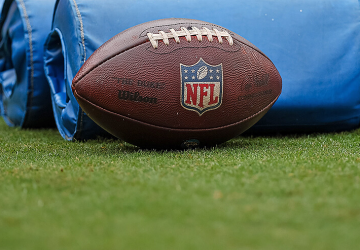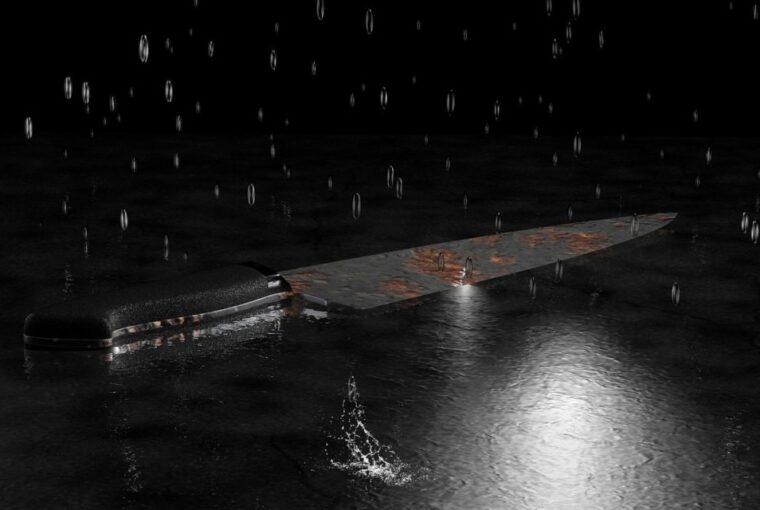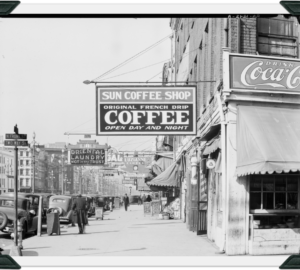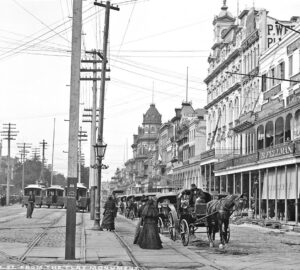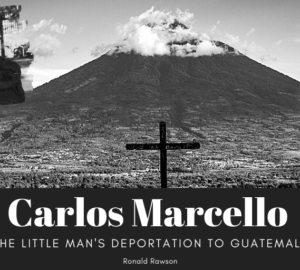On July 29 1942 at around 6:30 AM a woman’s body was discovered on the side of the road near Tucker’s Corner in upstate New York near Poughkeepsie. The body was that of Mrs. Yolanda Stroncone. She had been viciously stabbed 14 times with what was later determined to be a knife with a 5″ blade and an ice pick. Her car, money and a diamond ring was missing. Robbery was clearly a motive but since the attack was so brutal a personal motive was also suspected.
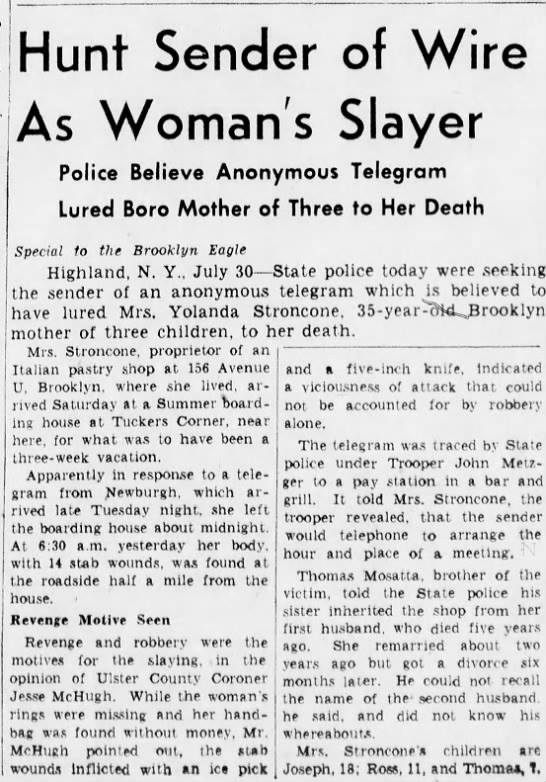
On July 25 the 37 year old mother of three boys closed up the Italian pastry shop in Brooklyn that she had inherited from her late husband who had passed in 1937. She kissed her children goodbye and set out on a vacation she had planned that would last about three weeks. Her brother Constantino drove her to Tucker’s Corner. Constantino, or Jerry as he went by, drove straight home to his wife and seven children. After he put the car in the garage he told his wife he was going out to buy a newspaper. He never returned. Early on Tuesday morning, July 28, Yolanda received a Western Union telegram at Dee’s Boarding House. She didn’t tell her fellow boarders who it was from, only that someone was going to call her to arrange a meeting for later that night. Yolanda left around midnight. The next day investigators traced the Western Union telegram as being sent from nearby Newburgh, about 15 miles from Tucker’s Corner. Yolanda’s body was found about a mile away from Dee’s. Though investigators didn’t have any ready suspects in the murder attention soon turned towards Brooklyn and her missing brother. It’s not clear if Constantino was a suspect at this time but on July 31 he was wanted for questioning.
Several months later authorities still had no definite answers to the murder mystery. Apparently though Constantino’s family, and his FAMILY, did. Yolanda and her brother didn’t come from a normal family. Their father Salvatore and his sons were early members of the D’Aquila Family which was later to be absorbed into what later became known as the Gambino Family. What was clear, or soon became so, to Constantino “Jerry” Masotto’s Family was that he had killed his sister, Yolanda Masotto Stroncone, and had gone into hiding. A contract was put out on Salvatore Masotto’s son.
Salvatore Masotto was born in Palermo in 1863 and came to America sometime between 1910 and 1913. He soon became an important part of the D’Aquila Family in New York and was to become a Capo under new Boss Vincent Mangano after the Castellamarese War. He had three sons. Constantino, Thomas and Victor and was related to the Gambino and Castellano families. Salvatore would not live to see the horror of his son’s murder of his sister. He died in Palermo in 1935. It’s unclear if Thomas and Victor were involved in Mafia activities but Constantino surely was. Born in Palermo in 1903 he had joined his father in New York in 1916. Apparently the only record Constantino had prior to the murder of his sister was in 1926 for assault and robbery to which he was sentenced to five months in prison. Constantino’s wife in New York would later say of her husband of 18 years:
“He was no good, no good at all. He never helped me raise our children and I want nothing to do with him.”
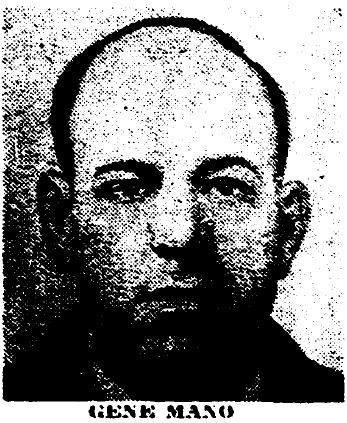
Gene Mano appears to have arrived in New Orleans around January of 1943 with his attractive new bride Theresa. Gene seems to have quickly found a job as a butcher in the French Market and soon after that had enough money to open his own stall next to his prior bosses stall. He was described by other stall operators there as someone who did not pay any particular attention to his business but always seemed to have plenty of money. Maybe because of his gambling which he quickly came to be known for. Other butchers suspected he may also be selling black market meat since it was a period of rationing due to the war. Whatever the case, things seemed to be good for Gene and Theresa until August of 1943. On Sunday August 8, Gene told Theresa he was having lunch with two friends and that she was invited to come along. Theresa later told police that she only knew the two men as Toto and Marsu. She also told of how Gene had met the two. Soon after Gene opened his French Market stall Toto and Marsu appeared there and would continually walk by “staring hard” at him. He told Theresa he planned on befriending the two to find out what they wanted of him. This being accomplished he soon had the two joining him at his home for dinner on several occasions. Theresa told Gene that she didn’t like them. “Let’s give them enough rope” was her husband’s response. On their way to the Willswood Tavern on the afternoon of August 8, Gene and Theresa had a flat tire. A passing motorist stopped to help them and was invited to join them for lunch. After a enjoying a convivial meal with his new acquaintances, the man who had stopped to help the Mano’s with their flat said goodbye. Gene soon said the same to Toto and Marsu and took Theresa home. To her surprise Gene, soon after arriving home, told her he needed to meet Toto and Marsu again at 6pm. He told her not to eat dinner without him and that he would soon be back as his meeting would not take long. When Gene did not return after several days she took over operations at his stall in the French Market. Curiously she did not report her husbands disappearance to police but placed an ad in the local paper saying “Gene, get in touch with me. Tess.” After about a month of no word from her husband Theresa left their French Quarter apartment and business to return to Washington D.C.
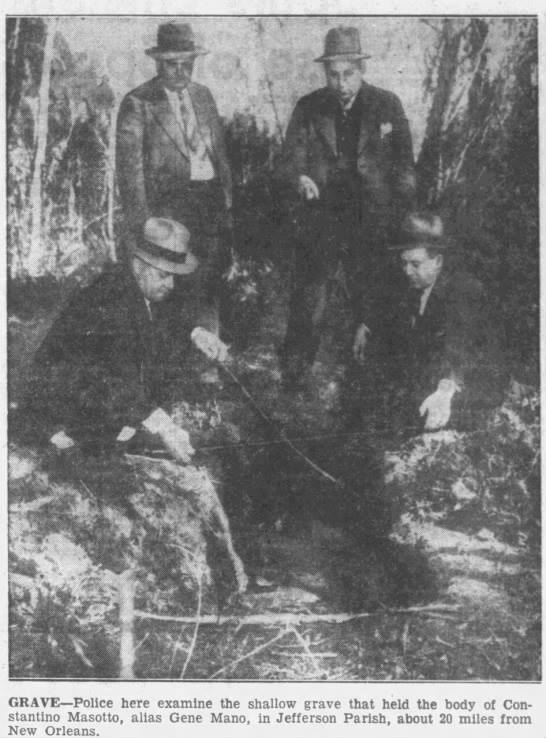
On November 10 1943 in the early evening two youths hunting rabbits in a wooded and swampy area let their dog lead them to a tangled spot in a lonely stretch. Their hunting hound apparently had another scent besides rabbits in his nose though as he took them to a shallow grave. The hunters made it to a phone and called police. They found a badly decomposed body that had been coated with a lime like substance. The body was not readily recognizable but a wallet found nearby the grave gave a clue. Though the wallet was empty Gene Mano’s name and address were stamped on it. The body was found about a mile from the Willswood Tavern. During the course of the investigation into Gene Mano and why he was murdered New Orleans Detective William Grosch found the true identity of Gene Mano to be Constantino Masotto and that he was wanted for questioning in New York about the murder of his sister Yolanda. Several weeks before the discovery of the body the police in New Orleans received several calls from unidentified persons, or a person, requesting information on the missing butcher. These calls were traced to New York. The New Orleans police requested help from the departments there and most likely the information about Mano/Masotto was revealed in the course of this. Theresa Mano also sent a message to Grosch saying that she had just read of the news of the discovery of her husband’s body in the local papers and that she would be returning to New Orleans. When she did return she told Grosch of the last day she saw her husband, the lunch and the meeting later that evening he had with his friends. Though she could not tell him what Toto and Marsu’s real names were she did know where Marsu lived. She also told Grosch that when Gene went for the meeting that evening he had a large amount of cash on him and was wearing an expensive diamond ring. Neither of which was found at the grave site or on the body. When Theresa took the police to Marsu’s address at 906 Wilson Dr. she soon pointed him out. Though they did not know the name Marsu the New Orleans Police knew Tommy Siracusa. A 42 year old saloon owner and professional gambler who they suspected of being in the narcotics racket with ties to New York. When questioned by police Siracusa admitted he was known as Marsu and told them that Toto was 40 year old Salvatore Vitale who lived at 1120 Dumaine St. Both men down played Theresa Mano’s version of events. They admitted to meeting Mano at his stall in the market but described it as a casual meeting. Siracusa admitted to having a meeting with Mano on the evening of the day he disappeared but said he was puzzled and hurt when Mano didn’t show up. Vitale remembered quite clearly that he played cards with several friends that same evening and denied having any appointment with Mano. When asked how he remembered so clearly his whereabouts on that particular evening of several months past Vitale said he didn’t know why, that it was just an odd coincidence. When asked about his whereabouts on August 9, the next evening, Vitale couldn’t account for himself. A detective then asked Vitale “Don’t you think it’s an even odder coincidence that Mano was buried so near the Willswood Tavern where you three spent so many happy hours together?” “That is strange isn’t it?” was Vitale’s answer. Mano was determined to have been killed by three blows to the head with an object, most likely a hammer, and that he had been killed in another spot than where the body was found.
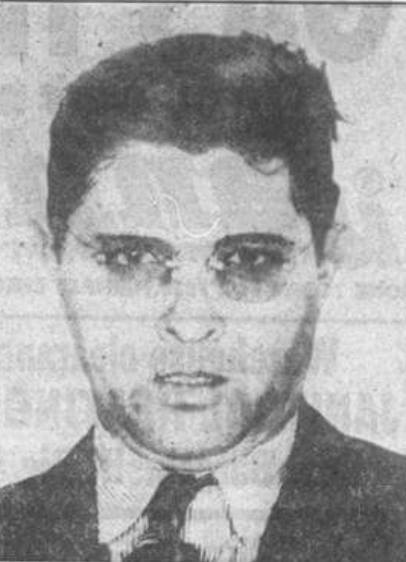
Constantino Masotto’s Family hadn’t forgotten about him and they still wanted him dead over the murder of his sister. The story goes that when they tracked him down to New Orleans the NOLA Family was asked to take care of it. It’s rumored Carlos Marcello is the one who did the deed on Masotto with an accomplice at the Willswood Tavern. It’s not quite clear how he was tracked down but Masotto may have done himself in. Two versions, both possibly true, give account of what may have led to Masotto’s murder. The first goes that when he first arrived in New Orleans he went to the butcher that originally gave him a job. Telling the butcher who he really was he claimed they were cousins and both had been born in the same town. Apparently the butcher believed him as he was given the job. Another version claims that just a few days prior to his disappearance Mano revealed his true identity to fellow stall owners in the market. Either, or both of these events probably helped those in New York track him down. In any event the hit was carried out and Yolanda was avenged. A couple of questions are left unanswered about his last day though. Was Mano supposed to show up alone for his lunch at Willswood Tavern that day? Would he have been clipped if he had? Did the presence of his wife Theresa and the motorist that stopped to help them give him a brief respite of a few hours? Would they have killed both of the Mano’s if the motorist had not joined them? The motorist was never named or even sought out as a witness as far as I’ve found. Was he really just a passing motorist? Siracusa and Vitale were arrested and questioned further on November 18 but Siracusa was released the next day on an appeal from his lawyer who told the court that there was no evidence against his client to warrant the arrest. Vitale was kept in the custody of Immigration officials as it was found that he was in an alien status and failed to report to authorities when he re-located to New Orleans. Siracusa was re-arrested on November 20 however and held without bond in the Gretna jail. On December 6 1943 both Vitale and Siracusa were indicted for the murder of Mano. Soon after each man was released on $10,000 bond. The trial was set for May 1944.
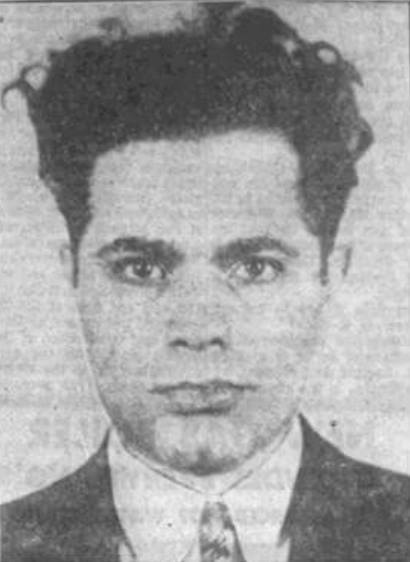
On February 10 1944 Tommy Siracusa’s wife walked into the New Orleans Police Headquarters and stated that her husband of 13 years had been missing for two days and, she thought, had been taken for a “ride”. When she was asked why she thought this she only replied “I don’t know, I just do”. On the evening of February 10, Siracusa had driven his wife to a movie theater and told her he would be back at 11pm to pick her up. When he never showed she made her way home. She said Tommy was usually considerate if he would be late and phone her. As midnight passed with no word from him she called his lawyer on the chance that he’d been arrested. She told police that Tommy didn’t have any enemies that she knew of and that he was a good husband to her and a good father to their ten year old boy Tommy Jr. Flyers were prepared to be circulated with a description of Tommy Siracusa: 42 years of age, 5’5″,165 pnds, bushy dark hair, big dark eyes and full lips. Wearing brown slacks, tan sports jacket and shoes, gray hat and red ribbed socks. Driving a 1938 sedan. When Salvatore Vitale was questioned about the disappearance of his friend he claimed that the two weren’t having much to do with each other due to the bad publicity over the Mano case but that he had run into him on the night of February 9 at the racetrack. He had not seen him since and told the police “Why don’t you ask his girlfriend?” Expressing surprise at this they responded that his wife described him as a good family man. Vitale just shrugged. The girl was tracked down. She worked as a hat check girl at a roadside tavern on the outskirts of town and though she admitted to knowing Siracusa for seven years she hadn’t seen him in several months. A four state APB was put out on Siracusa. On February 21 Siracusa’s car was found on parked on Elysian Fields Avenue. It was in gear, unlocked and with the keys in the ignition. It showed no signs of violence but was towed to the nearest station to be searched for clues. It was parked in an area near the river and a nearby resident told investigators that it had been parked there since the morning of February 11 when she noticed it at 6 am in the morning. It was ten blocks away from Siracusa’s girlfriends house and 40 blocks away from the theater where he had dropped his wife. Several weeks passed without anything new in the disappearance until March 9 1943. A service station attendant on Airline Hwy. took the license plate number of a man that fit the description of Tommy Siracusa and alerted police. The plate was traced to it’s owner who the attendant did not recognize as the driver that had stopped to fill up the car that night. Several days later on March 13 a body was fished out of the Mississippi River. It had been spotted tangled in a bunch of driftwood and refuse by a foreman of the Boland Machine and Manufacturing Company, a ship repair plant, who was working on a derrick at the time. The Coastguard was alerted and they proceeded to recover the remains. The nude body was badly disfigured and apparently had been covered at some point in a lime like substance which had helped decompose the body. The same as Gene Mano. Though unrecognizable the general specifications of the body fit those of Tommy Siracusa. The spot where the body was found floating was only roughly four blocks from where Siracusa’s car had been located. The body had three holes in it’s skull, both feet and it’s right hand was missing. Had Siracusa been found? The answer would come on the morning of Tuesday, April 3 1943.
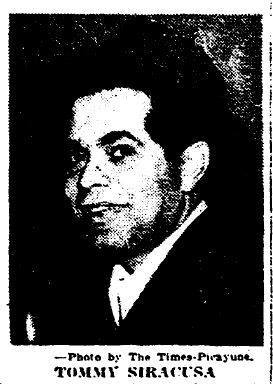
Phillip Boe, a dairyman, was driving around looking for stray cows on that morning when he found a badly decomposed and headless body on the side of Downman Road. A passing motorist, W.R.Eaton who was a civilian employee at the nearby Navy base, was flagged down by Boe and asked to contact police. The fully clothed body was almost in a skeletal state and impossible to identify. However the clothing found on it matched the clothes Tommy Siracusa was wearing when he disappeared. Found on the remains were gold rimmed glasses, a pocket comb in a leather case, about $7 in bills and change, a gold belt buckle with the initials T.S., a gold ring with four diamonds and a handkerchief with the letter S on it. Close to the body a wallet was found containing a draft registration card, a draft classification card, $65 in bills, an Italian Union member card, a social security card, a pawn ticket for 81.60 on a diamond stick pin, a drivers license and a memorandum book. All in the name of Tommy Siracusa. Tommy’s wife identified all of these objects as belonging to her husband as well as a picture of their son found in the wallet as well. Boe told police at the scene that he had passed by the area that Sunday and had not noticed the body. The area that the body was found in seemed only recently disturbed and so investigating further back from the road they found an area that showed signs that the body may have been resting there for a period. At first it was speculated that the head had been chopped off but then it was concluded that the head fell away from the body as it was dragged to the side of the road and left several feet from the body. Though most of Siracusa’s teeth were missing, most likely from being beaten, a dentist had done some work on Siracusa on February 8 and was able to ID his work with what was left in the skull. Though no certain cause of death could be determined, Tommy had been found.
The story of Tommy Siracusa’s last night appeared in FBI files in 1967. Though parts of it are redacted, some heavily, the most likely witness that talked to them was a Mrs. Rufus Navo. Navo had given a statement years earlier to Aaron Kohn that she had witnessed Carlos Marcello slapping someone around at the Willswood Tavern in 1944. Around 7pm on the night of February 10 1944 she (probably with at least one other person) arrived at the Willswood Tavern. There was only one other party present and they were already in the midst of their large meal. This other party consisted of Carlos Marcello, Joseph “Zip” Chimento, Vito Longo and Nick Christiana. all known members of the New Orleans Mafia. Along with them was Leah Longo (Vito’s wife) and her sister Jeanne. One individual who was not known to her was also present. A white male with a heavy complexion, around 40, heavy set, dark hair. This fits the general description of Salvatore Vitale. About 15 minutes later Tommy Siracusa arrived and at first seemed surprised to find the dinner going on. He quickly seemed to become concerned and afraid. Siracusa walked to the back of the bar and then to the kitchen where Vito Longo’s mother was cooking. Marcello, Chimento, Longo and Christiana immediately followed him where loud sounds of pots and pans being knocked around and falling to the floor and the sounds of a struggle ensued then a brief period of silence. When Longo’s mother opened the kitchen door Navo saw Siracusa tied to a chair and Chimento holding a snub nose .38 against his temple. Marcello was slapping him and Siracusa started yelling loudly in Italian. Unfortunately the information on what happened after that isn’t there but apparently a couple of days later after reading the headlines of Siracusa’s disappearance Navo went to several officials to tell them what she witnessed. One of those being Sheriff Frank Clancy. They all basically told her it was better for her if she didn’t repeat what she saw. Allegedly one also told her that Siracusa was killed over a $10,000 debt. Other versions of the reason for Siracusa’s killing was over narcotics. Both possible but several things leave questions about all this. Who was Navo that she was let into the Willswood Tavern at all? Much less when a murder was about to take place? And why would she be left alone when she showed a willingness to talk to law enforcement about this? Was Siracusa killed because of a bad debt and/or narcotics? It seems more likely it was connected to the Mano/Masotto killing. Were they afraid that Siracusa would talk at his upcoming trial in May? Had Siracusa already talked? And to the wrong person? Questions that will never be answered most likely! Why would someone drag Siracusa’s corpse to the side of the road after it had stayed so well hidden? Someone obviously wanted it found but why?
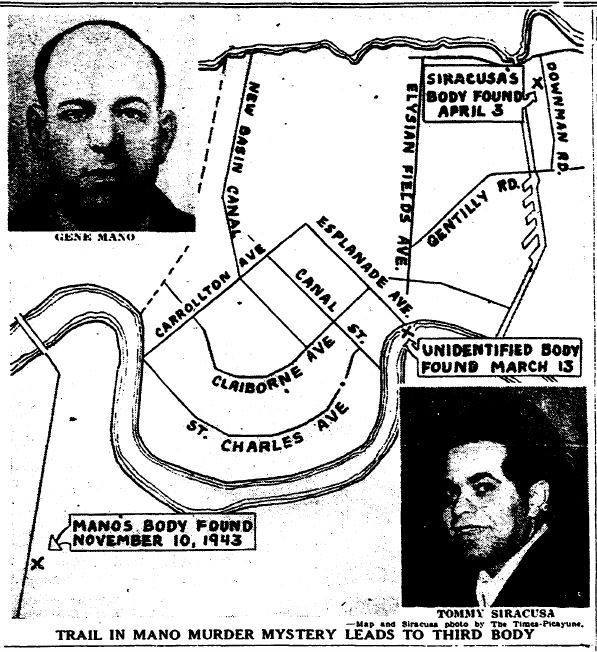
The questions don’t quite end with Siracusa’s death either. Salvatore Vitale was actually taken into custody the Saturday before Siracusa’s body was found. Presumably for the murder of Siracusa with the body that was fished out of the river and presumed to be his as evidence. Vitale walked into court on May 16 1944 for the trial in the case of Mano. He pleaded not guilty and the trial was granted a continuance. That was the last that was heard of any trials in the murders of Mano and Siracusa. Vitale never answered for the killings and in 1959 the murder indictment against him still showed no disposition. His $10,000 bond was never declared forfeit and the man listed as surety for the bond, Stefano Catalanotto (the Catalanotto name would later be associated with the NOLA Family), could not be located. Vitale has been lumped into the New Orleans Family as a member. This was not the case. Vitale was actually an early New York gangster with a record dating to 1930 for larceny, suspicion of murder, fraud and violations of Federal narcotics laws. He was associated with Carlo Gambino (though I couldn’t find definite statements that he was part of what would become the Gambino Family) as well as ties with Detroit. He appeared in New Orleans in November of 1942, though by way of Detroit and not New York. When exactly he left New Orleans isn’t known but after being indicted in New York on five counts of larceny he fled back to his hometown of Cinisi Sicily in 1957 where he apparently continued with his criminal activities. Was the timing of Vitale’s arrival in New Orleans just a coincidence being so close to Masotto’s arrival? Where was Masotto between his sister’s murder and his arrival in NOLA? Did Masotto know Vitale? Seems likely given the circumstances of each in New York. But if he did know Vitale why wouldn’t he have been afraid, or wary at least, of Vitale? He must have known there was a price on his head. Or, at the very least, suspected it. More questions that will never be answered!
And stranger things still: After Siracusa was declared legally dead and the day after he was buried a woman walked into New Orleans Police headquarters and reported to police clerk Robert Kuhn:”I’ve just seen Tommy Siracusa. He stepped out of a car and walked into the French Market. I couldn’t be mistaken. I know him quite well. What’s more, here’s the license number of the car that brought him.” She was accompanied by a man who stayed silent during the woman’s statement. Before the police could identify them they disappeared. It was never found who they were. The license plate number was traced to Joe Gagliano who was a known Family member and had a record of two narcotics violations at the time. Gagliano lived with close friends of Tommy Siracusa. When questioned he claimed that his car was in his garage at the time the woman claimed to see Siracusa step out of it. For months afterwards stories circulated that Siracusa was alive and working at a gas station somewhere in northern Louisiana. A woman who worked for a New Orleans newspaper started to check into these stories. One day she got a call from an unidentified man. “You have a little girl don’t you? If I were you I’d lay off the Siracusa case.” She laid off. Was there something more to the Siracusa case? Was the body found actually that of Siracusa’s? Could it all been an elaborate scheme for him to escape a possible murder rap? It would answer a few other questions if so.
And the body fished from the Mississippi River? Never found any information after the Siracusa case seemed solved. I don’t know if it ever did get identified.
- What’s This Silver Dollar Shit! That’s Sam Carollo! - June 26, 2023
- New Orleans Sets a Record - April 11, 2022
- Carlos Marcello Takes A Vacation: The Little Man’s Deportation to Guatemala Pt. 2 - June 11, 2021
